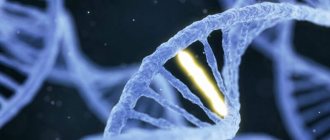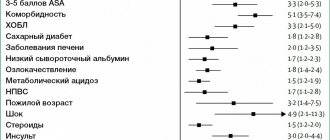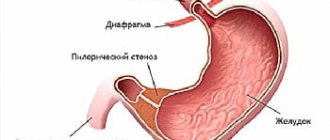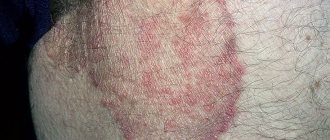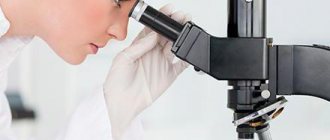Causes
The most common cause of peptic ulcer disease is infection with the bacterium Helicobacter pilory. It can be contracted through saliva through close contact with another person. In patients with duodenal ulcers, helicobacter is detected in 90% of cases; in patients with gastric ulcers, the figure is 50–60%.
In addition to bacteria, stress, poor diet and long-term use of non-steroidal drugs can be a provoking factor. Many people believe that a peptic ulcer is a complication of gastritis, but this is not true: these are different diseases and gastritis does not develop into a peptic ulcer.
Clinical manifestations
Pain from peptic ulcers is directly related to food intake.
At the same time, the important fact that the rate at which pain appears after eating depends on the height of the location of the pathological focus also has a diagnostic impact. The higher it is, the earlier the pain syndrome appears. In addition, the pain can be nocturnal or “hungry.” The latter variety appears on an empty stomach, but disappears soon after eating or during eating. Pain in gastric ulcers is always strictly localized; the patient can indicate the specific place where pain is present. In addition, ulcers often cause heartburn and a tendency to constipation.
Perforation of an ulcerative defect into the abdominal cavity is often characterized by the appearance of dagger pains, clinical signs of acute blood loss and pyogenic and hematogenous peritonitis (tension of the anterior abdominal wall, positive Shchetkin-Blumberg sign, etc.).
Treatment
Treatment depends on whether helicobacter is detected in the patient’s body or not. In the first case, the doctor prescribes two types of antibiotics, because one does not kill her, as well as drugs that create unfavorable conditions for the life of bacteria. Sometimes, after destroying the bacteria, the ulcer itself does not heal, then the patient is prescribed drugs that reduce secretion and improve tissue trophism. If helicobacter is not detected, antibiotics are not prescribed.
The course of treatment usually lasts 14 days, in certain cases it takes longer. Thus, a callous ulcer (large, advanced, with a diameter of more than 5 cm) can heal in 2-3 months. Usually, the defect grows to such a size in older people who have been taking non-steroidal drugs for years and have not checked their stomach. First of all, to heal it, the doctor stops the medications that cause peptic ulcers.
Operation
Treatment of peptic ulcers rarely requires surgery. It is only necessary in case of complications. For example, a perforated (perforated) ulcer can only be cured through surgery. The operation is also performed for massive bleeding, when it cannot be stopped conservatively, and for spinosis (narrowing of the duodenum).
Nutrition
To heal the defect, in addition to drug treatment, you must follow a diet. It consists of following a diet: a person should eat small portions 4-5 times a day, excluding spicy, salty, fried, smoked foods. All food must be boiled or steamed. When the ulcer heals, you no longer need to follow a diet, but you should still not abuse spicy, fried, smoked and salty foods. It is also important to eat regularly, without skipping meals, to prevent exacerbation. Alcohol is contraindicated for any gastrointestinal disease. Products that are best avoided: baked goods, brown bread, tomatoes, coffee, strong tea, lard, lamb fat, margarine, chocolate. The diet can include: dried wheat or yesterday's bread, crackers, savory cookies, milk soups, beef, chicken, pike perch, pike, perch, water porridge with the addition of milk (semolina, buckwheat, oatmeal, pearl barley, rice).
Classification of antiulcer drugs
- Histamine H2 receptor blockers (ranitidine, famotidine).
- Proton pump inhibitors (omeprazole, pantoprazole, esomeprazole, lansoprazole, rabeprazole).
- Prostaglandins (misoprostol).
- M1 – anticholinergics (pirenzepine).
- Antacids (sodium bicarbonate, magnesium carbonate, calcium carbonate, aluminum phosphate, magnesium hydroxide, aluminum hydroxide).
- Gastroprotectors (sucralfate, bismuth subcitrate, alginic acid).
- Agents for the eradication (destruction) of Helicobacter (amoxicillin, tinidazole, clarithromycin).
Diagnostics
To diagnose peptic ulcers, patients undergo fibrogastroscopy, during which they can do a quick urease test and be examined for helicobacter. Somewhere, additionally, pH measurements are performed in order to find out the level of acidity in the stomach. During this examination, a probe is inserted into the patient's stomach through the nose and acidity is measured throughout the day.
Early diagnosis of diseases of the gastrointestinal tract allows you to timely identify and prevent the risk of developing infectious, inflammatory and tumor diseases of the gastrointestinal tract, avoid the development of complications and the transition of the disease to a severe form. We care about the health of our patients and offer to use our programs for the prevention and treatment of diseases of the digestive system. These programs can be completed in 1 visit to the clinic.
You can make an appointment with a gastroenterologist at the Naedine Clinic by phone in Kirov: (8332) 32-7777 or through the form on the website
Peptic ulcer of the stomach and duodenum
Which doctors should I contact?
If symptoms of gastric and duodenal ulcers appear, you should contact or. The doctor will draw up an individual examination and treatment plan, taking into account the clinical form of the disease, and, if necessary, prescribe consultations with specialists. Observation is often required to select rational diet therapy, drug treatment and prevention of exacerbations. In case of development of surgical complications of peptic ulcer, consultation is necessary. In the presence of concomitant diseases, such as diabetes mellitus and heart failure, participation in the selection of therapy will be required. If a peptic ulcer has developed against the background of severe psycho-emotional stress, consultation with a medical psychologist or psychiatrist is necessary.
Treatment of gastric and duodenal ulcers
Treatment of gastric and duodenal ulcers is complex and includes diet therapy, medical conservative and surgical treatment. With conservative drug therapy for peptic ulcer associated with H. pylori, two eradication treatment regimens (aimed at destroying the pathogenic microorganism) are possible: three-component and four-component therapy.
Triple standard therapy includes proton pump inhibitors and antibacterial drugs of two groups in different dosages. In addition to the proton pump inhibitor and antibacterial drugs of two groups, the four-component therapy for peptic ulcer includes bismuth preparations.
Choosing a treatment regimen and calculating dosages of antibacterial drugs is the responsibility of the doctor, who will tell you in detail about the duration of therapy, the frequency of drug administration, and how to check the effectiveness of the chosen treatment.
If these treatment regimens are ineffective, individual options are used, selected taking into account sensitivity to antibacterial drugs.
In the case of peptic ulcer not associated with H. pylori, proton pump inhibitors and h2-blockers are used to reduce the secretion of hydrochloric acid and reduce the impact of aggressive factors on the mucous membrane of the wall of the stomach and duodenum. Also, to relieve symptoms for a short time, the doctor may prescribe antacids; in case of gastrointestinal motility disorders, antispasmodics and prokinetics.
Surgical treatment of peptic ulcer is used when complications develop that cannot be suppressed by conservative treatment methods.
Complications of gastric and duodenal ulcers
Complications of gastric and duodenal ulcers are life-threatening conditions.
If symptoms of a complicated ulcer appear, you should urgently seek medical help. Bleeding
is one of the most dangerous and rapidly developing complications of peptic ulcer disease. Its sign is the presence of blood in the vomit (black or dark brown vomit, “coffee grounds”) and/or black tarry stool. The development of bleeding is accompanied by pain, which stops abruptly, but sudden weakness and dizziness occur, blood pressure decreases, the pulse quickens, and loss of consciousness is possible. With minor bleeding, blood is found in the stool.
Perforation of the organ wall
accompanied by “dagger” pain in the abdomen, severe weakness, dizziness, weak pulse, low blood pressure, nausea, and vomiting.
Ulcer penetration
into neighboring organs (penetration) is characterized by abdominal pain, which can radiate to the back, vomiting, which does not bring relief.
Stenosis of the pyloroduodenal zone
, or narrowing of the ulcer site. As a result of a decrease in the diameter of the outlet of the stomach and duodenum, food stagnation occurs in the stomach, bad breath appears, vomiting of “yesterday’s” food, pain and a feeling of heaviness in the abdomen.
Peptic ulcer of the stomach and duodenum is a precancerous condition and increases the risk of developing stomach cancer
several times.
Prevention of gastric and duodenal ulcers.
Specific prevention of gastric and duodenal ulcers has not been developed.
The main measures to prevent ulcer formation include: normalizing the work and rest regime, giving up bad habits, eradicating H. pylori in infected individuals, limiting the use of painkillers (if long-term use of non-steroidal and steroidal anti-inflammatory drugs is necessary, they must be combined with antisecretory drugs).
An important component of the prevention of peptic ulcer disease and its relapse is adherence to the principles of proper nutrition.
Limit very hot and spicy dishes and alcohol. Long breaks between meals are unacceptable.
To prevent relapses of the disease, sanatorium-resort treatment is actively used. It is important for the patient to provide psycho-emotional peace and avoid stressful situations.
Sources:
- Peptic ulcer disease. Clinical recommendations of the Ministry of Health of the Russian Federation, 2021.
- Clinical guidelines of the Russian Gastroenterological Association for the diagnosis and treatment of peptic ulcers, 2016
IMPORTANT!
The information in this section cannot be used for self-diagnosis and self-treatment. In case of pain or other exacerbation of the disease, diagnostic tests should be prescribed only by the attending physician. To make a diagnosis and properly prescribe treatment, you should contact your doctor.
Ulcers of the pyloric stomach and duodenal bulb
Ulcers of the pyloric part of the stomach and duodenal bulb are characterized by “hungry” pain; after eating, you feel good for 1.5 - 2 hours until food is completely evacuated from the stomach, and then late pain occurs. Ulcers of the pyloric canal are characterized by severe pain, vomiting of acidic contents, persistent heartburn, paroxysmal excess salivation, a high incidence of pyloric stenosis and other complications. The average age of patients with duodenal ulcers is 10–15 years younger than with gastric ulcers; most often these are men under 40 years of age. A positive Mendelian sign is detected in the epigastrium on the right; the most common complication is perforation of the ulcer. When a duodenal ulcer is located on the posterior wall of the bulb, spasm of the sphincter of Oddi and the appearance of signs of gallbladder dyskinesia are often observed. Penetration of the ulcer into the pancreas and hepatoduodenal ligament is possible. With prolonged spasm of the sphincter of Oddi, girdling pain similar to pancreatitis may occur.
Ulcers of the subcardial stomach
Ulcers of the subcardial part of the stomach are characterized by the fact that after eating, early pain occurs during the first 30 minutes after eating, and then good health. The pain syndrome is usually unexpressed. Often, ulcers of this part of the stomach and esophagus are accompanied by pseudocardiac pain, aggravated by lying down. Men over 45 years of age are usually affected. Among the complaints, heartburn and belching predominate. Possible combination with hiatal hernia. The most common complication is bleeding.
Development factors, pathogenesis
Genetic factors for peptic ulcer disease are:
1) indicators of maximum secretion of hydrochloric acid;
2) increased gastrin release in response to food;
3) increased levels of pepsinogen-1 in blood serum;
4) pepsinogen-2 content in blood serum;
5) disorders of the motor-evacuation function of the stomach and duodenum;
6) congenital deficiency of alpha1-antitrypsin;
7) 0 (1) blood group (with the first blood group (0), membrane adhesion receptors to Helicobacter pylori are expressed to a much greater extent than people with other blood groups);
 genetically determined deficiency in gastric mucus of fucoglycoproteins - the main gastroprotectors;
genetically determined deficiency in gastric mucus of fucoglycoproteins - the main gastroprotectors;
9) inability to secrete AB blood agglutinogens into the stomach;
10) absence of the intestinal component and decreased alkaline phosphatase B index;
11) identification of HLA histocompatibility antigen B5, B15, B35;
12) absence of the third fraction of cholinesterase;
13) characteristic dermatoglyphic pattern;
14) altered taste ability of phenylthiourea.
Peptic ulcer is a consequence of an imbalance between protective (secretion of mucus, prostaglandins, bicarbonates, blood circulation, cellular renewal) and damaging (acid, pepsin, Helicobacter pylori, bile acids) factors. The predominance of aggressive factors over defensive factors is of primary importance.
Factors contributing to the occurrence of the disease
Neither gastric ulcer nor duodenal ulcer can appear without the influence of additional factors. As a rule, a combination of several components leads to peptic ulcer disease, the main of which are:
- Chronic gastritis, duodenitis or gastroduodenitis.
- Love for spicy dishes, constant consumption of monotonous or rough food. Food too cold and too hot.
- Violation of proper diet. Overeating, hasty eating with poor chewing. The body does not have time to secrete the required amount of enzymes needed to digest food; food is not evacuated from the stomach on time, but is retained in it, which leads to disruption of the digestion process.
- Impaired blood microcirculation. The mucous membrane has a dense network of blood capillaries. As soon as blood circulation in them is disrupted, the mucous membrane ceases to perform its protective functions in full.
- Constant overstrain of the nervous system, emotional stress, frequent anxiety states. In this case, the body’s protective properties are not simply reduced: the person’s appetite either disappears or becomes excessive, which, again, is a violation of the normal diet. At the same time, under stress, the functions of the autonomic nervous system, which is responsible for regulating the activity of the digestive organs, are disrupted.
- Hereditary predisposition.
- Long-term use of certain medications (non-steroidal anti-inflammatory drugs, painkillers, hormonal drugs, etc.).
- Excessive coffee consumption. The harmful effect of coffee manifests itself in stimulating the formation of excess gastric juice.
- Frequent or regular consumption of alcoholic beverages. Alcohol significantly reduces the protective properties of mucous membranes.
- Smoking. Resins containing carcinogenic substances enter the gastrointestinal tract along with saliva. Smoking increases the production of gastric juice, so smoking on an empty stomach is most harmful. If you do not stop smoking during treatment, this will significantly reduce the effectiveness of the latter.
Ultrasound of the abdominal organs
- Cost: 3,800 rub.
More details
Prevention
Preventive measures include maintaining a healthy lifestyle (with the exception of smoking, drinking strong alcoholic drinks), proper nutrition (it is necessary to avoid rushed eating, avoid eating large amounts of food, especially at night, very hot and spicy foods), abstaining from taking a number of medications drugs that reduce the protective properties of the mucous membrane of the stomach and duodenum (especially non-steroidal anti-inflammatory drugs). Sarklinik knows how to treat ulcers conservatively!
Sign up for a consultation. There are contraindications. Specialist consultation is required.
Photo: Bds | Dreamstime.com\Dreamstock.ru. The people depicted in the photo are models, do not suffer from the diseases described and/or all similarities are excluded.
Related posts:
Heartburn, burning in the stomach, treatment in Saratov, how to get rid of heartburn, what to do
Spasm of the esophagus: treatment, causes, how to relieve, treat cardiospasm of the esophagus, esophagospasm
Stomach ulcer, duodenal ulcer, peptic ulcer: treatment in Saratov
Hepatomegaly, steatosis, fibrosis, alcoholic hepatitis, liver cirrhosis, alcohol damage
Chronic gastritis: treatment in Saratov, how to treat inflammation of the stomach
Comments ()
Protective factors
Protective factors include:
1) Pg E2 regulates the protection of the mucous membrane;
2) Pg I2 ensures adequate blood flow;
3) a layer of mucus covering the entire surface of the mucous membrane;
4) surfactant-like substances that cover the mucous membrane with a hydrophobic barrier;
5) bicarbonates, neutralizing pH to 7 near the surface of the mucous membrane.
6) factors promoting regeneration (migration of epithelial cells; proliferation and differentiation of cells from the gastric glands into functionally active cells).
Symptomatic acute ulcers
A characteristic manifestation of an acute ulcer is necrosis and destruction of the epithelium of the mucous membrane, submucosal, and sometimes muscular layers. Healing of such an ulcer occurs by tissue regeneration, and not by replacing damaged layers with connective tissue, and scar formation does not occur.
Symptomatic ulcers occur against the background of impaired blood microcirculation in the mucous membrane, or, for example, as a side effect of taking nonsteroidal anti-inflammatory drugs, hormones, and salicylates.
Postbulbar ulcers
Postbulbar ulcers are characterized by intense pain. They occur as with ulcers of the duodenal bulb or later, but differ in that they do not subside immediately after eating, but after 15 to 20 minutes. The pain can be paroxysmal like colic. Postbulbar ulcers are more often observed in men aged 40–60 years. Distinctive clinical features of postbulbar ulcers are the difficulty of their diagnosis, including endoscopic, irradiation of pain to the scapula or lower back, frequent bleeding, development of perivisceritis, penetration. When the ulcer is localized near the major duodenal papilla, obstructive jaundice may occur due to compression of the common bile duct by the periulcerative inflammatory infiltrate.
Our services
The administration of CELT JSC regularly updates the price list posted on the clinic’s website. However, in order to avoid possible misunderstandings, we ask you to clarify the cost of services by phone: +7
| Service name | Price in rubles |
| Gastroscopy (videoesophagogastroduodenoscopy) | 6 000 |
| Breathing HELIK test (urease activity of H. Pylori) | 1 100 |
| Ultrasound of the abdominal organs (liver, gall bladder, pancreas, spleen) | 3 800 |
All services
Make an appointment through the application or by calling +7 +7 We work every day:
- Monday—Friday: 8.00—20.00
- Saturday: 8.00–18.00
- Sunday is a day off
The nearest metro and MCC stations to the clinic:
- Highway of Enthusiasts or Perovo
- Partisan
- Enthusiast Highway
Driving directions

